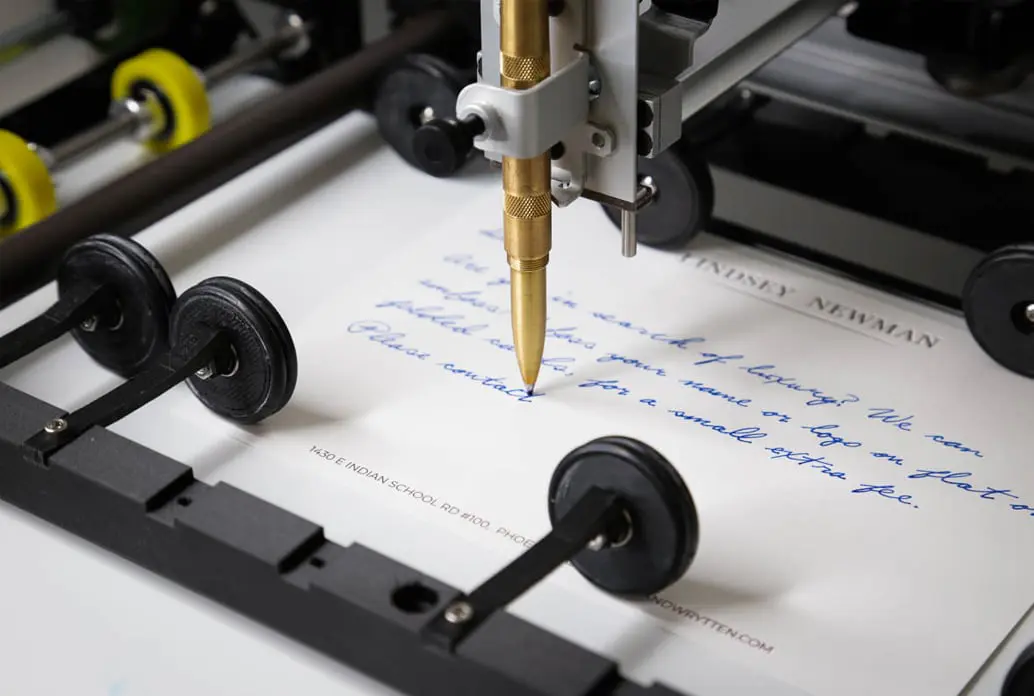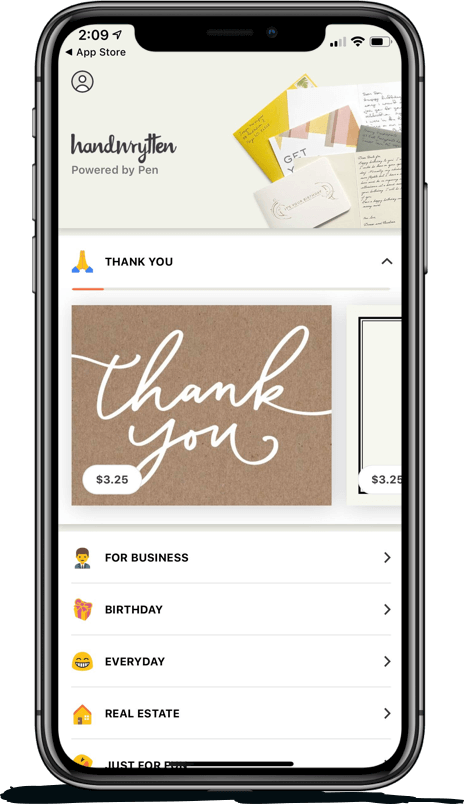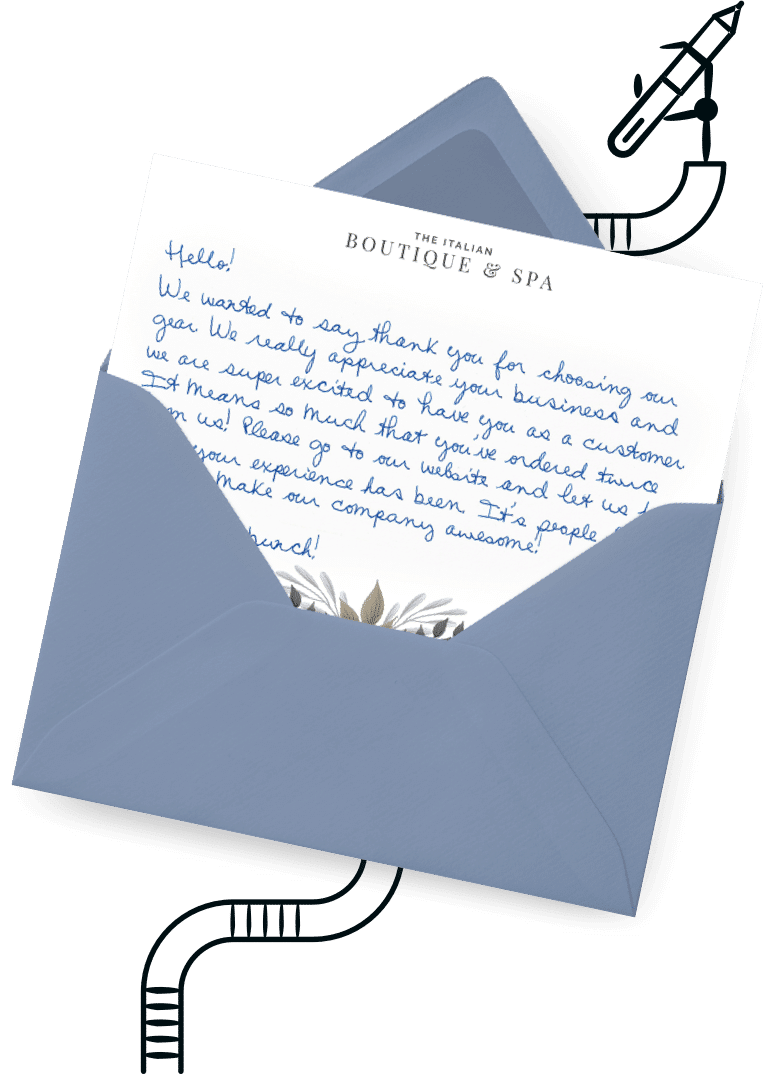
9280 S. Kyrene Rd.
Suite 134
Tempe, AZ 85284
Phone: +1 (888) 284-5197
Email: contact@handwrytten.com



You have been subscribed. Thank you!
Choosing the correct salutations can be crucial to your message’s impact. This guide will help you confidently pick the right greeting for any situation, ensuring your communication is respected and received as intended.
Salutations are the initial impression-makers. They not only set a professional tone but also serve as a fundamental component in building professional relationships. Ever wondered why we often start formal emails with ‘Dear [Name]’? It’s because such formal salutations convey respect and are the stepping stones for fostering business relationships.
The selection of the right salutation is an art, a subtle balance of formality and connection. Imagine receiving a professional email that starts with ‘Hey buddy!’ or a casual message from a close colleague starting with ‘Dear Sir or Madam’. Misplaced, isn’t it? The friendly greeting in a formal setting seems off, and the overly formal salutation in an informal context, is out of place. Hence, choosing the best salutations can make a significant impact on how our message is perceived.
The choice of salutation is not a one-size-fits-all solution. It varies depending on:
Selecting an appropriate salutation for your professional email or cover letter requires thoughtful consideration. A formal context might require a ‘Dear Mr.’ or ‘Good Morning, [Name]’, while a more casual setting could be enough with a simple ‘Hi’ or ‘Hello’.
Adapting email salutations to align with the context and the professional relationship with the recipient is key in professional communication. An informal salutation like ‘Hey [Name]’ might be acceptable in an email to a close colleague, but it may not convey the same respect to a senior executive or a new client. This is why it’s essential to double-check and adjust the formality level according to the recipient’s culture, preferences, and the purpose of the email.
The power of the right salutation extends beyond the boundaries of formality. It holds the potential to grab the recipient’s attention and contribute to a positive first impression. A cheerful hello or a joyful salutation can mirror joy, and positivity, and reflect the strength of the bond between the sender and recipient.
Including a personal touch in salutations, such as echoing sincere wishes for success and happiness, serves as a reminder of unwavering support and good wishes. This fosters a deeper connection and demonstrates genuine interest in the recipient and their needs.
Formality is a language of its own in professional communication. When crafting formal correspondence, such as business meetings or cover letters, precision is paramount. It’s not just about using grand words and complex sentences; it’s about detailing and respecting the recipient’s identity.
Using the recipient’s full name or their preferred title followed by the last name is a practice that conveys respect and professionalism. Traditional greetings and closings like ‘Dear [Name]’ and ‘Yours sincerely’ are more than just words; they are signs of respect and acknowledgment.
Titles are more than just prefixes; they are a recognition of one’s qualifications, achievements, and position. When addressing someone in formal communications, using a title such as ‘Dr.’, ‘Professor’, or ‘Mr./Ms.’ with the recipient’s last name is an indication of respect and professionalism. However, be cautious. Misusing titles or not double-checking the spelling of names can reflect poorly on one’s professionalism.
It’s also important to acknowledge the recipient’s professional position or status correctly. This can help create a successful exchange of emails and foster stronger business relationships. And let’s not forget the importance of inclusivity. Using gender-neutral terms in salutations respects inclusivity and avoids potential misgendering, making your communication more respectful and considerate. Here are some examples of gender-neutral salutations you can use:
Balancing politeness and connection in salutations is a tightrope walk. On one hand, you want to maintain a professional tone, and on the other hand, you want to foster a personal connection. This balance can be achieved by addressing the recipient by name, using their job title, or referencing their department.
Cordial salutations that skillfully blend friendliness with professionalism can foster stronger relationships and affirm a professional image. Starting emails with amicable and professional salutations, like ‘Hi [First Name]’, encourages a sense of closeness while preserving an appropriate level of formality. Using a professional salutation can effectively communicate respect, enthusiasm, or sincerity based on the existing relationship with the email recipient.
A direct but polite opening statement such as ‘I’m reaching out about…’ prevents the wasting of time and demonstrates consideration for the reader.
Personalization is the secret sauce that can make your professional emails stand out. Mentioning recent interactions or shared events in email greetings can strengthen the relationship with the recipient and encourage a quicker response. Recording important personal details of the recipient contributes to more effective and individualized communication, laying the foundation for a stronger professional relationship.
However, personalization doesn’t mean using non-specific titles like ‘Dear Sir/Madam’. Such greetings can appear impersonal and outdated, potentially harming the professional rapport. It’s also important to respect diversity by including personal pronouns in email signatures. This can foster an environment where others feel encouraged to share their own pronouns.
While formal salutations have their place, informal salutations can be just as potent in the right context. They are appropriate when communicating with colleagues you are closely working with or clients with whom you’ve established a good rapport, helping to foster a friendly and relaxed tone.
The choice of informal salutations in the workplace reflects the sender’s character, allowing expressions of personality and warmth while maintaining a professional demeanor. Some commonly used informal salutations include:
These salutations aid in establishing politeness and warmth.
It is important to tailor informal salutations to suit both the occasion and the nature of the relationship you have with the recipient, ensuring appropriateness and respect, as the same rules apply to all forms of communication.
Tone plays a critical role in casual salutations. An informal tone can foster camaraderie and convey your personality without sacrificing professionalism. Matching the recipient’s language in the tone of casual salutations shows an understanding of the relationship, increasing the personal connection.
However, caution is necessary. While mimicking the recipient’s informal language can demonstrate attentiveness to past interactions and help solidify bonds, using slang or overly casual language in professional emails may be perceived as unprofessional and cause misunderstandings.
The level of formality in a salutation can be determined by the nature of the relationship with the receiver. Closer or long-standing professional relationships often warrant more casual salutations.
On the other hand, using an overly formal greeting may seem awkward and stiff when connecting with someone you have previously interacted with. So, it’s important to adjust the level of formality based on the dynamics of the relationship to ensure appropriateness and respect in communication.
I hope this message finds you well. I’m writing to discuss [specific topic].
[Your Name]
I wanted to touch base regarding [specific topic]. Could we schedule a meeting to discuss this further?
Best regards,
[Your Name]
I hope you’re having a great day. I wanted to bring [specific topic] to your attention and see how we should proceed.
Sincerely,
[Your Name]
I’m reaching out to provide an update on [specific project or task]. Please let me know if you have any feedback or need further information.
Best,
[Your Name]
I wanted to share some thoughts on [specific topic]. Would you be available for a quick discussion sometime this week?
Warm regards,
[Your Name]
6. Dear [Recipient Name],
I can’t stop thinking about the wonderful dinner we had last night. You make my heart flutter every moment we spend together.
With all my love,
[Your Name]
7. Greetings my love,
I wanted to let you know how grateful I am to have you in my life. Your smile brightens my day and fills me with joy.
Forever yours,
[Your Name]
8. Good morning [Recipient Name],
Waking up next to you is the best part of my day. I can’t wait to see what the future holds for us.
With all my heart,
[Your Name]
9. Hello darling,
I’ve been reminiscing about our first date and how magical it was. I fall in love with you more each day.
Yours always,
[Your Name]
10, Hi sweetheart,
Just a quick note to say I love you. Thinking about you brings a smile to my face and warmth to my heart.
Love always,
[Your Name]
11. Hey [Friend’s Name],
I hope you’re doing fantastic! I just wanted to catch up and see how things are going with you.
Best,
[Your Name]
12. Hiya [Friend’s Name],
It’s been a while, and I’ve been thinking about our last hangout. Let’s plan another get-together soon!
Cheers,
[Your Name]
13. Hello [Friend’s Name],
Just dropping a quick note to say hi and see if you’re free for a chat this weekend.
Take care,
[Your Name]
14. What’s up [Friend’s Name]?
I hope you’re having an awesome day! Let’s catch up and share some laughs like we always do.
Talk soon,
[Your Name]
15. Greetings [Friend’s Name],
I miss our fun times together! Let’s grab a coffee or go on an adventure sometime soon.
Warm regards,
[Your Name]
16. Dear Mom and Dad,
I hope you’re both doing well. I just wanted to check in and share some recent updates from my life.
Love,
[Your Name]
17. Hello Mom and Dad,
I miss you both so much! Let’s plan a visit soon so we can catch up properly.
Hugs,
[Your Name]
18. Hi Mom, Hi Dad,
Thinking of you and hoping everything is great on your end. Can’t wait to see you both soon!
Best,
[Your Name]
19. Greetings Mom and Dad,
I wanted to let you know how much I appreciate everything you do for me. Your support means the world to me.
[Your Name]
20, Good morning Mom and Dad,
Just wanted to say that I’ve been thinking about you and I’m grateful for having such wonderful parents.
With warmest regards,
[Your Name]
21. Dear [Service Professional’s Name],
I am reaching out to express my gratitude for the exceptional service you provided. Your expertise and attention to detail made all the difference.
Thank you,
[Your Name]
22. Hello [Service Professional’s Name],
I wanted to take a moment to thank you for your outstanding work and dedication. Your efforts are truly appreciated.
Best regards,
[Your Name]
23. Hi [Service Professional’s Name],
Your professionalism and skill have greatly impressed me. I look forward to working with you again in the future.
Sincerely,
[Your Name]
24. Greetings [Service Professional’s Name],
Just a quick note to acknowledge the excellent job you did on [specific task or project]. Your hard work does not go unnoticed.
Warm regards,
[Your Name]
25. Good morning [Service Professional’s Name],
I wanted to commend you for the top-notch service you’ve provided. Your commitment to quality is evident in everything you do.
Best,
[Your Name]
26. Hey [Coworker’s Name],
I hope you’re having a productive day! Just wanted to touch base about [specific project or task].
Best,
[Your Name]
27. Hi [Coworker’s Name],
I had a quick question regarding [specific topic]. Do you have a moment to chat?
Thanks,
[Your Name]
28. Hello [Coworker’s Name],
I wanted to follow up on our recent discussion about [specific project]. Looking forward to your insights.
Cheers,
[Your Name]
29. Good morning [Coworker’s Name],
I hope you had a great weekend! Let’s catch up on [specific task or meeting] when you have a chance.
Regards,
[Your Name]
30. Greetings [Coworker’s Name],
I appreciate all your hard work on [specific project]. Keep up the fantastic job!
Best regards,
[Your Name]
Navigating the landscape of salutations can be tricky. Being aware of common pitfalls can help us communicate more effectively. The tone of our salutations should neither carry a stiff tone nor suggest a careless approach. Misspelling a person’s name in an email salutation can give the impression that the message is not written with care or attention to detail.
The way we start our emails matters too. The email introduction ‘I know you’re busy, but…’ should be avoided as it implies assumptions about the reader’s time and attention.
Knowing how to appropriately start and end emails, and how to navigate the less structured world of messaging can lead to effective workplace correspondence.
Striking the right balance between formality and informality in salutations is like finding the sweet spot in a continuous spectrum. On one end, you have salutations like ‘Dear Sir or Madam’ and ‘To whom it may concern’, which are often seen as outdated and impersonal, creating a hindrance to effective communication. On the other end, using slang, abbreviations, nicknames, or pet names in salutations can be perceived as unprofessional unless a familiar relationship has been established with the recipient.
Differentiating between overly formal and too casual salutations is critical to avoid seeming either distant or unprofessional. Balancing the level of formality in salutations is key to conveying professionalism while also fostering a connection with the recipient.
Emails are a daily part of our lives, and we often find ourselves flooded with them. Respecting the recipient’s time and attention while drafting an email message is a mark of professionalism. Using a personalized salutation rather than a generic greeting like ‘To whom it may concern’ demonstrates respect for the recipient and their time.
Personalized greetings help in making the communication feel more personable and thus can enhance the connection with the recipient. An ineffective salutation may result in the recipient ignoring the email altogether, highlighting the importance of the right greeting.
Balancing the use of personalized salutations with the goal of engaging the reader is critical in showing respect for the recipient’s time and attention.
The salutation of an email should match its content. An overly casual salutation for an email containing serious content can confuse the recipient, while an overly formal salutation for a casual update might seem out of place. The tone of casual salutations should match the overall tone and purpose of the message, fostering an atmosphere of approachability when appropriate.
It’s also respectful to start an email with a direct statement of the message’s goal. This sets clear expectations for the recipient and demonstrates consideration for their time.
Wouldn’t it be wonderful if your salutations could consistently strike the perfect balance between professionalism and warmth, creating lasting impressions on your recipients? That’s where Handwrytten steps in! With Handwrytten, you can elevate your communication by sending personalized, beautifully crafted handwritten notes that stand out in the sea of digital correspondence. Imagine the impact a thoughtfully written, custom note could have on a client or colleague – it’s a simple yet powerful gesture that showcases your attention to detail and commitment to meaningful interactions.
Handwrytten offers a variety of handwriting styles to match your brand’s voice, ensuring every note feels authentic and personable. Whether you’re welcoming a new team member, thanking a client for their business, or simply reaching out to reconnect, Handwrytten’s platform makes it easy to create memorable connection points that resonate deeply with your audience.
Why settle for ordinary when you can be extraordinary? Try Handwrytten today and discover how a small touch of authenticity can enhance your professional relationships. Visit our website to get started and experience the charm of handwritten salutations in your daily communications!
In summary, salutations, while a small part of our communications, play a significant role in setting the tone of our interaction and shaping relationships. The choice of salutation should consider the recipient’s position, familiarity, and cultural background, the formality of the context, and the impression we wish to convey.
A balance of formality, politeness, and personal connection can result in salutations that are respectful, and professional, and foster a sense of camaraderie. Avoiding common pitfalls, such as overly formal or too casual greetings, and respecting the recipient’s time and attention are crucial in effective communication.
Salutations are important in professional emails because they set the tone, show respect, and help in building professional relationships.
You should use formal salutations in formal contexts, like business meetings or formal correspondence, and when addressing someone of higher authority or someone you don’t have a close relationship with. Keep this in mind to maintain proper etiquette.
Using informal salutations in professional emails is suitable when communicating with close colleagues or clients, as it fosters a friendly and relaxed tone while maintaining professionalism.
To balance politeness and connection in salutations, use the recipient’s name, job title, or department to maintain respect while adding a personal touch. This creates a professional and personalized communication experience for the recipient.
To avoid common salutation pitfalls, be mindful of using overly formal or too casual salutations, misspelling the recipient’s name, making assumptions about their time, and not matching the salutation tone with the message content. Avoid these pitfalls to ensure effective communication.


Scale your handwritten outreach, creating positive impressions and long lasting bond.
Sign Up Today!


Over 100 designs to choose from or design your own. Our online card customizer makes it simple.
Check Out Our Cards!





